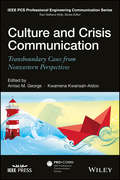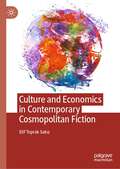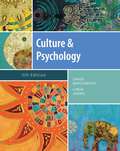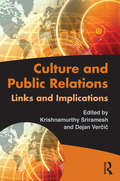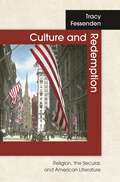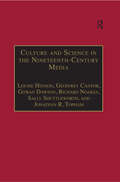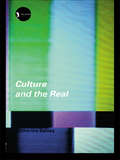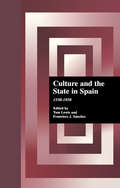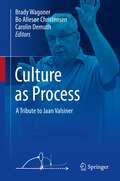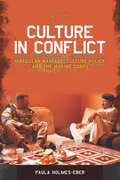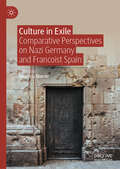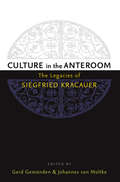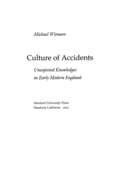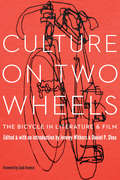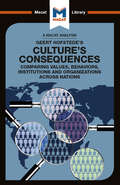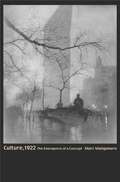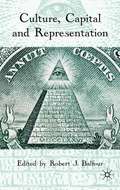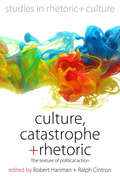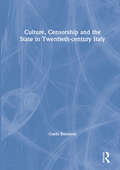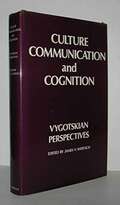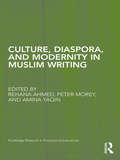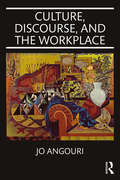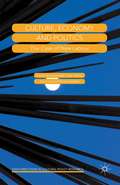- Table View
- List View
Culture and Crisis Communication: Transboundary Cases from Nonwestern Perspectives
by Amiso M. George Kwamena Kwansah-AidooA collection of case studies from nonwestern countries that offers an analysis of the significant role culture plays in crisis communication Culture and Crisis Communication presents an examination of how politics, culture, religion, and other social issues affect crisis communication and management in nonwestern countries. From intense human tragedy to the follies of the rich, the chapters examine how companies, organizations, news outlets, health organizations, technical experts, politicians, and local communities communicate in crisis situations. Taking a wider view than a single country’s perspective, the text contains a cross-cultural and cross-country approach. In addition, the case studies offer valuable lessons that organizations that wish to operate or are operating in those cultures can adopt in preparing and managing crises. The book highlights recent crisis events such as Syria’s civil war, missing Malaysia Flight MH370, andJapan’s Fukushima Daiichi nuclear power plant disaster. Each of the case studies examines how culture impacts communication and responses to crises. Authoritative, insightful, and instructive, this important resource: Analyzes how nonwestern cultures respond to crises Covers the role of culture in crisis communication in recent news events Includes contributions from 18 international authors who provide insight on nonwestern culture and crisis communication Written for communication professionals, academics, and students, Culture and Crisis Communication presents an insightful introduction to the topic of culture and crisis communication and then delves into illustrative case studies that explore intra-cultural and trans-boundary crisis communication.
Culture and Economics in Contemporary Cosmopolitan Fiction
by Elif Toprak SakızThis book investigates how culture and economics define novel forms of cosmopolitanism and cosmopolitan fiction. Tracing cosmopolitanism’s transition from universalism to vernacularism, the book opens up new avenues for reading cosmopolitan fiction by offering a precise and convenient set of terminology. The figure of the cosmoflâneur identifies a contemporary cosmopolitan character’s urban mobility and wandering consciousness in interaction with the global and the local. Posthuman cosmopolitanism also extends the meaning of cosmopolitan which comes to embrace the nonhuman alongside the human element. Defining narrative glocality, political hyper-awareness, and narrative immediacy, the book thoroughly explores how cosmopolitan narration forges direct responses to the contemporary world in postmillennial cosmopolitan novels. All of these concepts are elaborated in Ian McEwan’s Saturday (2005), Zadie Smith’s NW (2012), Salman Rushdie’s The Golden House (2017), and Kazuo Ishiguro’s Klara and the Sun (2021), to which world-engagement is central.
Culture and Psychology (5th Edition)
by David Matsumoto Linda JuangThis book puts psychological theories and concepts into a cross-cultural framework that invites readers to discover, question, and ultimately, understand the relationship between culture and psychology through exploration of topics like changing gender roles, sexuality, self-esteem, aggression, personality, and mate selection.
Culture and Public Relations: Links And Implications (Routledge Communication Series)
by Dejan Verčič Krishnamurthy SrirameshCulture and Public Relations explores the impact of culture – societal and organizational – through the global lens of public relations. Structuring the volume around three themes -- culture as an environment for public relations; the culture of PR globally; and the impact of PR on culture -- the editors bring together compelling discussions on such questions as how spirituality, religion, and culture have affected public relations, and how public relations culture has been affected by the "corporate cultures" of business enterprises. Additionally, the volume provides studies on the effect of culture on public relations practice in specific countries. With contributors from Europe, Asia, Australia, and North America, this collection offers international perspectives on a topic that is growing increasingly important in public relations study and practice. It is required reading for scholars, researchers, and students in public relations and also has much to offer the business discipline, for those seeking to integrate culture and communication to their practices.
Culture and Redemption: Religion, the Secular, and American Literature
by Tracy FessendenMany Americans wish to believe that the United States, founded in religious tolerance, has gradually and naturally established a secular public sphere that is equally tolerant of all religions--or none. Culture and Redemption suggests otherwise. Tracy Fessenden contends that the uneven separation of church and state in America, far from safeguarding an arena for democratic flourishing, has functioned instead to promote particular forms of religious possibility while containing, suppressing, or excluding others. At a moment when questions about the appropriate role of religion in public life have become trenchant as never before, Culture and Redemption radically challenges conventional depictions--celebratory or damning--of America's "secular" public sphere. Examining American legal cases, children's books, sermons, and polemics together with popular and classic works of literature from the seventeenth to the twentieth centuries, Culture and Redemption shows how the vaunted secularization of American culture proceeds not as an inevitable by-product of modernity, but instead through concerted attempts to render dominant forms of Protestant identity continuous with democratic, civil identity. Fessenden shows this process to be thoroughly implicated, moreover, in practices of often-violent exclusion that go to the making of national culture: Indian removals, forced acculturations of religious and other minorities, internal and external colonizations, and exacting constructions of sex and gender. Her new readings of Emerson, Whitman, Melville, Stowe, Twain, Gilman, Fitzgerald, and others who address themselves to these dynamics in intricate and often unexpected ways advance a major reinterpretation of American writing.
Culture and Science in the Nineteenth-Century Media (The Nineteenth Century Series)
by Sally Shuttleworth Geoffrey Cantor Gowan Dawson Richard Noakes Jonathan R. Topham Louise HensonWritten by literary scholars, historians of science, and cultural historians, the twenty-two original essays in this collection explore the intriguing and multifaceted interrelationships between science and culture through the periodical press in nineteenth-century Britain. Ranging across the spectrum of periodical titles, the six sections comprise: 'Women, Children, and Gender', 'Religious Audiences', 'Naturalizing the Supernatural', 'Contesting New Technologies', 'Professionalization and Journalism', and 'Evolution, Psychology, and Culture'. The essays offer some of the first 'samplings and soundings' from the emergent and richly interdisciplinary field of scholarship on the relations between science and the nineteenth-century media.
Culture and the Real: Theorizing Cultural Criticism (New Accents)
by Catherine BelseyWhat makes us the people we are? Culture evidently plays a part, but how large a part? Is culture alone the source of our identities? Some have argued that human nature is the foundation of culture, others that culture is the foundation of human identity. Catherine Belsey calls for a more nuanced, relational account of what it is to be human, and in doing so puts forward a significant new theory of culture. Culture and the Real explains with Professor Belsey's characteristic lucidity the views of recent theorists, including Jean-François Lyotard, Judith Butler and Slavoj Zizek, as well as their debt to the earlier work of Kant and Hegel, in order to take issue with their accounts of what it is to be human. To explore the human, she demonstrates, is to acknowledge the relationship between culture and what we don't know: not the familiar world picture presented to us by culture as 'reality', but the unsayable, or the strange region that lies beyond culture, which Lacan has called 'the real'. Culture, she argues, registers a sense of its own limits in ways more subtle than the theorists allow.This volume builds on the insights of Belsey's influential Critical Practice to provide not only an accessible introduction to contemporary theories of what it is to be human, but a major new contribution to current debates about culture. Taking examples from film and art, fiction and poetry, Culture and the Real is essential reading for those studying or working in cultural criticism, within the fields of English, Cultural Studies, Film Studies and Art History.
Culture and the State in Spain: 1550-1850 (Hispanic Issues)
by Tom Lewis Francisco J. SánchezThis volume address the role of literature in the formation of cultural notions of 'state,' 'nation,' 'subject,' and 'citizen' in Spain from the Renaissance to the Romantic period. It brings together literary scholars and historians of the Golden Age and the eighteenth and nineteenth centuries in a dialog framed by the rise and dissolution of the Absolutist state. Individual essays attempt to understand relationships between subjectivity and the state in Spain from the earliest articulations of the subject to the consolidation of an array of bourgeois subjectivities. The major argument running throughout the volume is that literary discourse, from the time it emerges in the sixteenth century to the time it coheres within a wholly modern concept of the aesthetic, actively develops forms of subjectivity in relation to institutions of class power. The intention of the volume is to clarify central problems regarding the emergence and function of literature across distinct modes of production, state formations, and hegemonic cultures. This book keeps open a debate on the long process through which literature and the aesthetic come to be constituted as a complex arena in which-sometimes directly, more often indirectly-the struggle for state power unfolds.
Culture as Process: A Tribute to Jaan Valsiner
by Brady Wagoner Bo Allesøe Christensen Carolin DemuthJaan Valsiner has made numerous contributions to the development of psychology over the last 40 years. He is internationally recognized as a leader and innovator within both developmental psychology and cultural psychology, and has received numerous prizes for his work: the Alexander von Humboldt prize, the Hans Killian prize, and the Outstanding International Psychologist Award from the American Psychological Association. Having taught at Universities in Europe, Asia and north and south America, he is currently Niels Bohr professor at Aalborg University, Denmark. This book is the first to discuss in detail the different sides of Valsiner’s thought, including developmental science, semiotic mediation, cultural transmission, aesthetics, globalization of science, epistemology, methodology and the history of ideas. The book provides an overview, evaluation and extension of Valsiner’s key ideas for the construction of a dynamic cultural psychology, written by his former students and colleagues from around the world.
Culture in Conflict: Irregular Warfare, Culture Policy, and the Marine Corps
by Paula Holmes-EberIn response to the irregular warfare challenges facing the U. S. in Iraq and Afghanistan in 2005, General James Mattis#151;then commander of Marine Corps Combat Development Command#151;established a new Marine Corps cultural initiative. The goal was simple: teach Marines to interact successfully with the local population in areas of conflict. The implications, however, were anything but simple: transform an elite military culture founded on the principles of "locate, close with, and destroy the enemy" into a "culturally savvy" Marine Corps. Culture in Conflict: Irregular Warfare, Culture Policy, and the Marine Corps examines the conflicted trajectory of the Marine Corps' efforts to institute a radical culture policy into a military organization that is structured and trained to fight conventional wars. More importantly, however, it is a compelling book about America's shifting military identity in a new world of unconventional warfare.
Culture in Conflict: Irregular Warfare, Culture Policy, and the Marine Corps
by Paula Holmes-EberIn response to the irregular warfare challenges facing the U. S. in Iraq and Afghanistan in 2005, General James Mattis#151;then commander of Marine Corps Combat Development Command#151;established a new Marine Corps cultural initiative. The goal was simple: teach Marines to interact successfully with the local population in areas of conflict. The implications, however, were anything but simple: transform an elite military culture founded on the principles of "locate, close with, and destroy the enemy" into a "culturally savvy" Marine Corps. Culture in Conflict: Irregular Warfare, Culture Policy, and the Marine Corps examines the conflicted trajectory of the Marine Corps' efforts to institute a radical culture policy into a military organization that is structured and trained to fight conventional wars. More importantly, however, it is a compelling book about America's shifting military identity in a new world of unconventional warfare.
Culture in Exile: Comparative Perspectives on Nazi Germany and Francoist Spain
by Elisenda MarcerThis edited book breaks new ground by bringing together research on inner and territorial exile in the context of National Socialism in Germany and the Franco regime in Spain, and in proposing an integrated model of exilic cultural production. Original contributions explore previously neglected aspects of the inner and territorial exile cultures, focusing on the specificity of the national settings (including Catalonia) whilst also seeking to place research findings within a conceptual framework of exile which views the experiences and cultural manifestations of inner and territorial exiles not as polar opposites, but as interactions of response to fascist dictatorship. This book will be of interest to scholars and students of German Studies, Hispanic Studies, comparative literary and cultural studies, and modern history more broadly.
Culture in the Anteroom: The Legacies of Siegfried Kracauer
by Johannes Von Moltke Gerd GemündenCulture in the Anteroom introduces an English-speaking readership to the full range of Siegfried Kracauer's work as novelist, architect, journalist, sociologist, historian, exile critic, and theorist of visual culture. This interdisciplinary anthology---including pieces from Miriam Bratu Hansen, Andreas Huyssen, Noah Isenberg, Lutz Koepnick, Eric Rentschler, and Heide Schlüpmann---brings together literary and film scholars, historians and art historians, sociologists, and architects to address the scope and current relevance of a body of work dedicated to investigating all aspects of modernism and modernity. The contributors approach Kracauer's writings from a variety of angles, some by placing them in dialogue with his contemporaries in Weimar Germany and the New York Intellectuals of the 1940s and '50s; others by exploring relatively unknown facets of Kracauer's oeuvre by considering his contributions to architectural history, the history of radio as well as other new media, and museum and exhibition culture.
Culture of Accidents: Unexpected Knowledges in Early Modern England
by Michael WitmoreCollapsing buildings, unexpected meetings in the marketplace, monstrous births, encounters with pirates at sea--these and other unforeseen "accidents" at the turn of the seventeenth century in England acquired unprecedented significance in the early modern philosophical and cultural imagination. Drawing on intellectual history, cultural criticism, and rhetorical theory, this book chronicles the narrative transformation of "accident" from a philosophical dead end to an astonishing occasion for revelation and wonder in early modern religious life, dramatic practice, and experimental philosophy. Embracing the notion that accident was a concept with both learned and popular appeal, the book traces its evolution through Aristotelian, Scholastic, and Calvinist thought into a range of early modern texts. It suggests that for many English writers, accidental events raised fundamental questions about the nature of order in the world and the way that order should be apprehended. Alongside texts by such canonical figures as Shakespeare and Bacon, this study draws on several lesser-known authors of sensational news accounts about accidents that occurred around the turn of the seventeenth century. The result is a cultural anatomy of accidents as philosophical problem, theatrical conceit, spiritual landmark, and even a prototype for Baconian "experiment," one that provides a fresh interpretation of the early modern engagement with contingency in intellectual and cultural terms.
Culture of Encounters: Sanskrit at the Mughal Court (South Asia Across the Disciplines)
by Audrey TruschkeCulture of Encounters documents the fascinating exchange between the Persian-speaking Islamic elite of the Mughal Empire and traditional Sanskrit scholars, which engendered a dynamic idea of Mughal rule essential to the empire's survival. This history begins with the invitation of Brahman and Jain intellectuals to King Akbar's court in the 1560s, then details the numerous Mughal-backed texts they and their Mughal interlocutors produced under emperors Akbar, Jahangir (1605–1627), and Shah Jahan (1628–1658). Many works, including Sanskrit epics and historical texts, were translated into Persian, elevating the political position of Brahmans and Jains and cultivating a voracious appetite for Indian writings throughout the Mughal world. The first book to read these Sanskrit and Persian works in tandem, Culture of Encounters recasts the Mughal Empire as a polyglot polity that collaborated with its Indian subjects to envision its sovereignty. The work also reframes the development of Brahman and Jain communities under Mughal rule, which coalesced around carefully selected, politically salient memories of imperial interaction. Along with its groundbreaking findings, Culture of Encounters certifies the critical role of the sociology of empire in building the Mughal polity, which came to irrevocably shape the literary and ruling cultures of early modern India.
Culture on Two Wheels: The Bicycle in Literature and Film
by Zack Furness Jeremy Withers Daniel P. SheaBicycles have more cultural identities than many realize, functioning not only as literal vehicles in a text but also as “vehicles” for that text’s themes, ideas, and critiques. In the late nineteenth century the bicycle was seen as a way for the wealthy urban elite to reconnect with nature and for women to gain a measure of personal freedom, while during World War II it became a utilitarian tool of the French Resistance and in 1970s China stood for wealth and modernization. Lately it has functioned variously as the favored ideological steed of environmentalists, a means of community bonding and aesthetic self-expression in hip hop, and the ride of choice for bike messenger–idolizing urban hipsters. Culture on Two Wheels analyzes the shifting cultural significance of the bicycle by examining its appearances in literary, musical, and cinematic works spanning three continents and more than 125 years of history. Bringing together essays by a variety of cyclists and scholars with myriad angles of approach, this collection highlights the bicycle’s flexibility as a signifier and analyzes the appearance of bicycles in canonical and well-known texts such as Samuel Beckett’s modernist novel Molloy, the Oscar-winning film Breaking Away, and various Stephen King novels and stories, as well as in lesser-known but equally significant texts, such as the celebrated Russian director Andrei Tarkovsky’s film Sacrifice and Elizabeth Robins Pennell’s nineteenth-century travelogue A Canterbury Pilgrimage, the latter of which traces the route of Chaucer’s pilgrims via bicycle. Listen to an interview with the author.
Culture's Consequences: Comparing Values, Behaviors, Institutes and Organizations across Nations (The Macat Library)
by Katherine ErdmanThe Dutch anthropologist Geert Hofstede is recognized as a pioneer in the fields of international management and social psychology – and his work is a perfect example of the ways in which interpretative skills can help solve problems and provide the foundation for strong thinking and understanding both in business and beyond. Hofstede’s central achievement was setting up an efficient interpretative framework for understanding the cultural differences between one country and another. Working for the international computing company IBM in the late 1960s, Hofstede noted that such cultural differences had huge consequences for international organizations. Up until then, while many inside and outside of business recognized the importance of these differences, little had been done to define precisely what cultural difference was and in what areas of life it was expressed. Hofstede’s insight was that if one could interpret and define the dimensions of cultural difference, it would be possible to measure them and act accordingly. From a vast survey of IBM’s employees in several countries, Hofstede originally defined five dimensions of culture: every society could be rated for each dimension, providing a useful guide to the kinds of cultural differences at play. As ever, good interpretative skills provided the basis for better understanding.
Culture, 1922: The Emergence of a Concept
by Marc ManganaroCulture, 1922 traces the intellectual and institutional deployment of the culture concept in England and America in the first half of the twentieth century. With primary attention to how models of culture are created, elaborated upon, transformed, resisted, and ignored, Marc Manganaro works across disciplinary lines to embrace literary, literary critical, and anthropological writing. Tracing two traditions of thinking about culture, as elite products and pursuits and as common and shared systems of values, Manganaro argues that these modernist formulations are not mutually exclusive and have indeed intermingled in complex and interesting ways throughout the development of literary studies and anthropology. Beginning with the important Victorian architects of culture--Matthew Arnold and Edward Tylor--the book follows a number of main figures, schools, and movements up to 1950 such as anthropologist Franz Boas, his disciples Edward Sapir, Ruth Benedict, and Zora Neale Hurston, literary modernists T. S. Eliot and James Joyce, functional anthropologist Bronislaw Malinowski, modernist literary critic I. A. Richards, the New Critics, and Kenneth Burke. The main focus here, however, is upon three works published in 1922, the watershed year of Modernism--Eliot's The Waste Land, Malinowski's Argonauts of the Western Pacific, and Joyce's Ulysses. Manganaro reads these masterworks and the history of their reception as efforts toward defining culture. This is a wide-ranging and ambitious study about an ambiguous and complex concept as it moves within and between disciplines.
Culture, Capital and Representation
by Robert J. BalfourWith contributions ranging over three centuries, Culture, Capital and Representation explores how literature, cultural studies and the visual arts represent, interact with, and produce ideas about capital, whether in its early phases (the growth of stock markets) or in its late phase (global speculative capital).
Culture, Catastrophe, and Rhetoric: The Texture of Political Action (Studies in Rhetoric and Culture #7)
by Robert Hariman and Ralph CintronThis volume explores political culture, especially the catastrophic elements of the global social order emerging in the twenty-first century. By emphasizing the texture of political action, the book theorizes how social context becomes evident on the surface of events and analyzes the performative dimensions of political experience. The attention to catastrophe allows for an understanding of how ordinary people contend with normal system operation once it is indistinguishable from system breakdown. Through an array of case studies, the book provides an account of change as it is experienced, negotiated, and resisted in specific settings that define a society’s capacity for political action.
Culture, Censorship and the State in Twentieth-century Italy
by Guido BonsaverThis book brings together literary critics, political historians, historians of literature, cinema and theatre and cultural sociologists, to elucidate a fundamental area of enquiry into modern Italian history: the nature and scope of relations between the state and the cultural sphere.
Culture, Communication And Cognition: Vygotskian Perspectives
by James V. WertschCulture, Communication, and Cognition: Vygotskian Perspectives
Culture, Diaspora, and Modernity in Muslim Writing (Routledge Research in Postcolonial Literatures)
by Peter Morey Amina Yaqin Rehana AhmedFiction by writers of Muslim background forms one of the most diverse, vibrant and high-profile corpora of work being produced today - from the trail-blazing writing of Salman Rushdie and Hanif Kureishi, which challenged political and racial orthodoxies in the 1980s, to that of a new generation including Mohsin Hamid, Nadeem Aslam and Kamila Shamsie. This collection reflects the variety of those fictions. Experts in English, South Asian, and postcolonial literatures address the nature of Muslim identity: its response to political realignments since the 1980s, its tensions between religious and secular models of citizenship, and its manifestation of these tensions as conflict between generations. In considering the perceptions of Muslims, contributors also explore the roles of immigration, class, gender, and national identity, as well as the impact of 9/11. This volume includes essays on contemporary fiction by writers of Muslim origin and non-Muslims writing about Muslims. It aims to push beyond the habitual populist 'framing' of Muslims as strangers or interlopers whose ways and beliefs are at odds with those of modernity, exposing the hide-bound, conservative assumptions that underpin such perspectives. While returning to themes that are of particular significance to diasporic Muslim cultures, such as secularism, modernity, multiculturalism and citizenship, the essays reveal that 'Muslim writing' grapples with the same big questions as serve to exercise all writers and intellectuals at the present time: How does one reconcile the impulses of the individual with the requirements of community? How can one 'belong' in the modern world? What is the role of art in making sense of chaotic contemporary experience?
Culture, Discourse, and the Workplace
by Jo Angouri*SHORTLISTED FOR THE 2019 BAAL BOOK PRIZE* Culture, Discourse, and the Workplace brings new theoretical and methodological insights to the complex relationship between language, culture, and identity in professional settings. Examining the politics of language use at work via a critical sociolinguistic approach, this book: Utilises three case studies from institutional and business contexts to provide a unique illustration of participants’ roles and ways of negotiating membership within the business meeting; Questions essentialist meanings of culture and the ways in which they constitute a powerful resource for employees to perpetuate or challenge the status quo in their professional setting; Includes a core section on methodology for the workplace discourse researcher as well as a section dedicated to FAQs and a worked example on data analysis; Provides future directions for workplace sociolinguistics as a field and makes a case for holistic research and multidisciplinary enquiry. Culture, Discourse, and the Workplace constitutes a key resource for students and teachers of intercultural communication and ESP and will also be of significant interest to researchers in the fields of workplace studies and business interaction.
Culture, Economy and Politics: The Case of New Labour (New Directions in Cultural Policy Research)
by David Lee David Hesmondhalgh Kate Oakley Melissa NisbettThis book focuses on cultural policy in the UK between 1997 and 2010 under the Labour party (or 'New Labour', as it was temporarily rebranded). It is based on interviews with major figures and examines a range of policy areas including the arts, creative industries, copyright, film policy, heritage, urban regeneration and regional policy.
